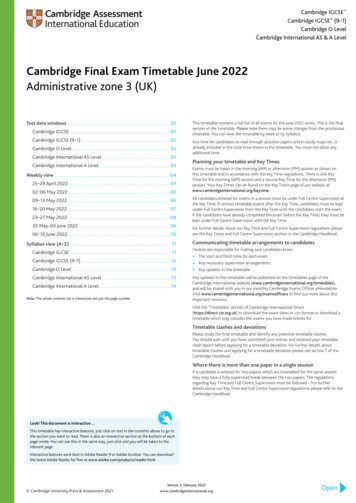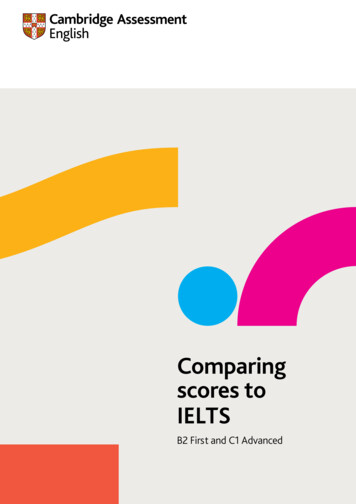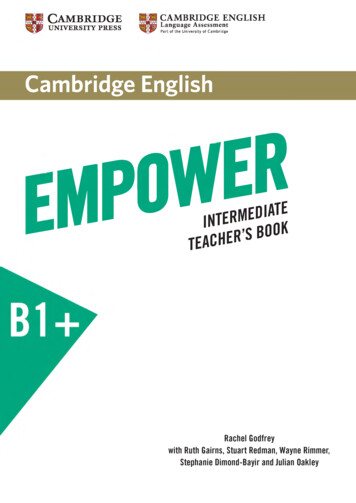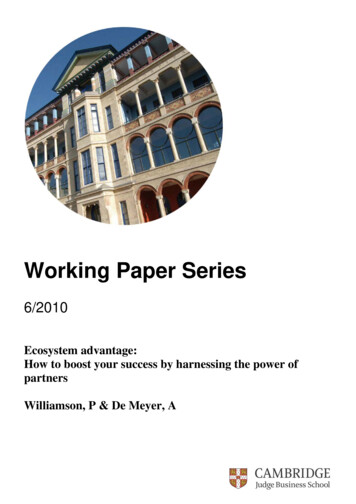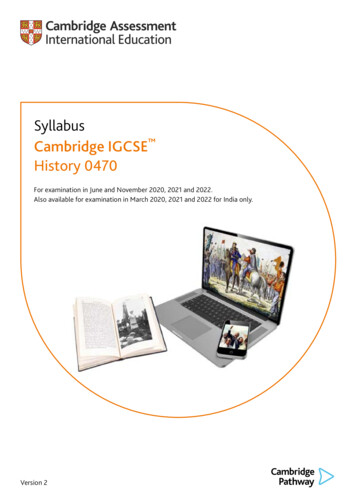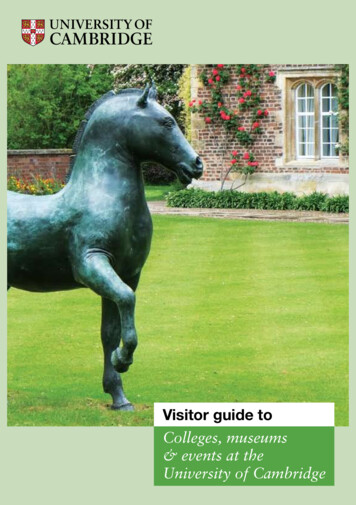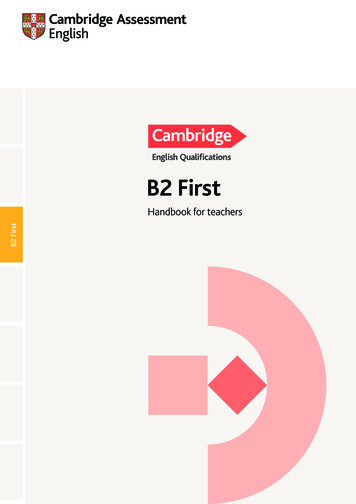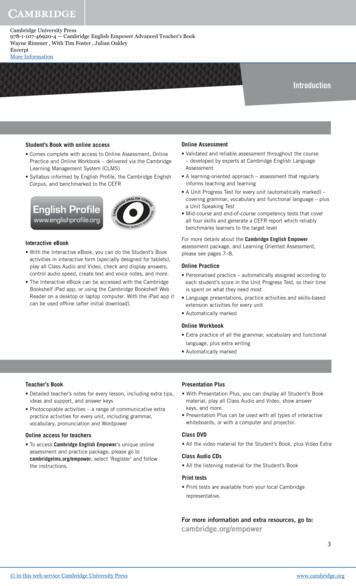
Transcription
C2C1A2 KeyA2 Key for SchoolsClassroom activitiesB2B1A2A1PreA1These activities are based on topics fromthe A2 Key/A2 Key for Schools word list andclassroom posters.
A2 Key/A2 Key for Schools Lesson plansLesson 1Lesson 1 – Roll the diceThis lesson plan works with all the posters for A2 Key for Schools.Timing: 40 minutesAim: To review and activate vocabularySkills: Speaking for fluency, listening for detail, writing for fluencyMaterials: Vocabulary poster and the wordlist for the poster (see Appendix 1 from lesson plan 1), sets of dice,pens and paper, vocabulary notebooksPreparation: Cut the wordlist into packs of word cards for each group. On the back of each card write a numberbetween 1 and 6 (do not worry if there are duplicate numbers).ProcedureWarmer: Write the name of the topic shown on the poster on the board. Brainstorm words with the class andwrite them on the board. Show the class the poster and discuss. Compare with the words the class thought ofon the board. Explain that the class is going to work with the words that appear on the poster.1 Define it!Distribute one set of vocabulary cards and dice to each group. Groups lay out the cards on their desk with thewords face down, so that they can see the numbers but not the words.Students take turns to roll the dice. The student who rolls the dice chooses a card that corresponds to thenumber. The student looks at the card to reveal the word, but does not show or tell the group their word. Thestudent describes the word to the group, e.g. ice cream: ‘it’s cold, I like strawberry, and my sister likes chocolate’.The group guesses the word. They can look at the poster to help them. The student who guesses the word keepsthat card and then rolls the dice to choose the next word. The student with the most cards at the end wins.2 Use it!The group turns the cards face down again so the students can see the numbers but not the words.Students take turns to roll the dice. The student who rolls the dice chooses a card that corresponds to the number.The student looks at the card to reveal the word, and makes a sentence that includes the word. The next studentrolls the dice and chooses the next word. Monitor for errors and conduct feedback at the end of the task.3 Write it!The group turns the cards face down again so students can see the numbers but not the words.Students take turns to roll the dice and choose a word, until each member of the group has rolled the diceand chosen at least three words. Divide each group into pairs. Give the students 10–15 minutes to work togetherto discuss, plan and draft a short story in their notebooks. They have to use all the words they have chosen. Theycan also refer to the words they brainstormed on the whiteboard in the warmer. Pairs regroup with other pairs toshare their stories. Conduct whole-class feedback and invite students to share their stories with their classmates.Extension activityStudents write a final draft of their stories in class or for homework. Make a classroom display of the storiesaround the poster.01
A2 Key/A2 Key for Schools Lesson plansAppendixAppendix: Lesson plan 1 – A2 Key for Schools word cardsA2 e and forkfruithealthyhungryice creamjuicekitchensupermarketmenumineral waterovenpizzafridgesnackslicewash e01
A2 Key/A2 Key for Schools Lesson plansAppendixA2 segameget petitionpoolruntennis racketsailsnowboardsports 02
A2 Key/A2 Key for Schools Lesson plansAppendixA2 Our pringsummerautumnwinter03
A2 Key/A2 Key for Schools Lesson plansLesson 2Lesson plan 2 – Integrated skills lessonThis lesson plan works with all the posters for A2 Key for Schools.Timing: 40–60 minutes but activities can be made shorter if necessaryAim: Vocabulary review and vocabulary buildingSkills: Speaking for fluency, raising awareness of pronunciation and stress, writing for accuracyMaterials: Vocabulary poster, pens, notebooks, A4 blank paperPreparation: Cut the blank A4 pieces of paper into 10–15 strips, make one set of strips for each groupProcedureWarmer: Hold up a copy of the poster you are using in the lesson and/or attach to the board. Write the topicon the board. Explore and practise the vocabulary on the poster e.g. concept check the meaning, model anddrill pronunciation.Drilling activities could include: Repetition drills – give clear, natural-sounding models:– Hand movements – model the word, use your fingers to count the syllables with the class. Class repeats.– Find the stress – model the word, class repeats and ask them to identify the stressed syllable.– Clap the beat – model, clap out the syllables, focus on the stressed syllable, class repeats.– Standing stress drill – model the word, the class repeats and stands up when they say the stressed syllable.– Whisper drill – whisper the word and the class whispers back.– Shouting drill – shout the word and the class shouts back.1 Speaking for fluencyGenerate a whole-class discussion around the topic indicated on the poster to encourage the class to use some ofthe vocabulary. Suggested topic starters for each poster are indicated in the box below.Topic starters – Talking about and around the topicA2 Food poster – favourite/least favourite foods; a food you have never tried; a food you have tried but don’twant to try againA2 Our planet poster – Which do you prefer: town or country? Why? Crowded or quiet? Why? Sun or moon?Why?A2 Sport poster – Who likes sport? Why? Why not? Which sport? Who plays sport? Which sport? How often?Who with? Which sport do you want to try? Why?01
A2 Key/A2 Key for Schools Lesson plansLesson 22 Against the clock – 60-second vocabulary buildingStudents work in pairs. They have one minute to think of any extra words connected to the topic. Encourage thestudents to think about nouns, adjectives, adverbs and verbs; all words are good words! Pairs make a record oftheir words in their notebooks.After one minute, the pairs team up with another pair and compare the words they have thought of.Encourage pairs to explain any unfamiliar words. Students make a record of new words in their notebooks.Extension and support optionAgainst the clock. With the dictionary if the class has difficulty thinking of any extra words. Pairs can workwith a dictionary to find words related to the topic that they record in their notebooks. This helps developresearch skills.Set a time limit. Conduct whole-class feedback. Make a record of the new words the class has identified on theboard, check understanding, and drill pronunciation and stress. Invite the students to make a record of new wordsin their notebooks.3 Story timeStudents work in pairs or groups of four. Distribute a set of blank slips of paper to each group. The groupchooses five words from the poster and from the Against the clock activity. They write each word on a separateslip of paper.The group works together and plans a story. They have to use all the words they have chosen. If they don’t likethe words they have chosen they can select up to three new words.Teacher monitors and supports groups during the activity. At the end of the planning phase, groups nominatea story teller/s for story time.Feedback. Pairs/groups invite another group to come and see the words they have chosen. The story tellers telltheir story. At the end of the story, the group who listened to the story invites the story tellers to come and seethe words they have chosen and to listen to their story.Whole-class feedback. Give whole-class feedback on the stories you have heard around the class. Ask whetherany of the students would like to share their story with the class. Students may not be forthcoming, so givefeedback on the range of stories you have heard in class, with a focus on the range of vocabulary used, stressand intonation.Extension activityStudents write their story in their notebooks for homework. They have to give their story a title and write a listof the words they have used at the top of the page.Explain the success criteria: A story with 20 or more words. The story has to include the five words they have chosen. The story must be linked to the title they have chosen. The story has to be easy for the reader to understand.02
A2 Key/A2 Key for Schools Lesson plansLesson 3.1Lesson plan 3.1 – Food poster storyThis lesson plan is for the A2 Key for Schools Food poster – see alternative lesson plans 3.2 and 3.3 forthe Sport poster and Our planet poster.Timing: 40–60 minutes (activities can be made shorter if necessary)Aim: To review vocabulary and question formationSkills: Listening for gist and for detail, speaking for accuracy and fluency, writing for accuracyMaterials: A2 Food poster, word cards (see Appendix from lesson 1), story attached to the poster, handoutgap-fill questions and blank questions boxPreparation: Cut up the word cards – one set per group/pair. Make copies of handout – one for each studentProcedureWarmer: Review of the vocabularyHold up a copy of the poster, attach to the board. Write the topic on the board. Discuss the theme and thepicture with the students.1. Concept checking meaning and pronunciationDiscuss, explore and practise the vocabulary that appears on the poster, e.g. concept check the meaning, modeland drill the pronunciation (see Lesson plan 2 for suggested drilling activities).2. Listening for the main ideasTell the students you are going to read a short story that includes words from the poster. Tell them to listencarefully and that you will ask them questions to see how much they can remember.Food story‘Welcome to the programme. This is the first in a series about health and fitness. We want to find out howhealthy our students are. Today we are talking to David.Hello David! We are trying to find out about what our students eat on a typical school day.’‘What do I eat? Breakfast is my favourite meal of the day. I usually have a cup of coffee, some fruit andbread and cheese. I take a snack to eat at break time, and I always carry a bottle of water with me, I drink twolitres of water a day. I don’t eat lunch because I always play football at lunchtime. At the end of the day, I walkhome from school with my friends and two or three times a week, we stop at the café. We buy chips, maybepizza or a burger. I know it’s not very healthy, and it is expensive. I think I have quite a healthy lifestyle and diet,what do you think?’Check understanding of the story with questions:1. What is David’s favourite meal of the day?2. What does David eat at school?01
A2 Key/A2 Key for Schools Lesson plansLesson 3.13. How often does David go to the café?4. Who does David go to the café with?5. What do David and his friends usually buy when they go to the café?6. How healthy do you think David’s lifestyle and diet is?Extension speakingEncourage the students to discuss the final question (How healthy do you think David’s lifestyle is?) in open classand encourage them to give their opinion about David’s lifestyle.3. Listening for detaila. Put the students into groups.b. Distribute a set of word cards from the poster to each group. The students set out the cards on their tables sothey can see the words.c. Hold up the poster. How many of the words from the poster do the students think were in the story?d. Ask students to guess. Take feedback and make a record of their guesses on the board.e. Read the story again to listen and check.f. A s the students listen, when they hear a word from the list, they turn the word card over(so they can’t see the word).g. At the end of the story, tell the students NOT to turn over the cards to check the words.h. Students work together to remember the words they heard and write them in their notebooks.Ask them to count how many words they heard and check with the predictions on the board. Which student wasthe closest?Key: Total 15: breakfast, favourite, coffee, fruit, bread, cheese, snack, bottle, water, lunch, café, chips, pizza,burger, healthy4. Question time – grammar reviewTell students they are going to take a closer look at the questions you asked at the end of the story, but this time,they are going to complete the questions.Conduct a whole-class review of:a. Question words – e.g. what, where, when, who, how often, whyb. The grammar associated with question formation – auxiliary infinitive, to be questionsc. The grammar associated with the answers.5. Question time – controlled practicea. Hand out the gap-fill questions and answers.b. Students work together to complete Task 1.c. Monitor and check for errors.d. Conduct whole-class feedback.02
A2 Key/A2 Key for Schools Lesson plansLesson 3.1e. Differentiationa. Weaker students – Distribute copies of the food story for the weaker students so they can read the text.b. Stronger students – Encourage stronger students to plan one or more new questions that they would askDavid about his lifestyle.6. Question time – semi-controlled writing, speaking for fluency, listening for detaila. S tudents plan up to six interview questions on the worksheet (Appendix 2) or in their notebooks to findout what their partner eats in a typical day.b. Students listen to their partner and make a note of their answers.c. M onitor as they do this and conduct whole-class feedback – what did the students find out abouttheir partner?d. Discuss in open class how healthy the students are.e. W rite example questions and answers that emerge from monitoring and from whole-class feedback on theboard, e.g. we think that Juan is very healthy because he eats fruit and vegetables.7. Extension/Homework – How healthy is my partner?Students use their notes with the questions they asked and the information their partner gave to write aparagraph. They have to decide how healthy they think their partner is and write a sentence with their opinion.03
A2 Key/A2 Key for Schools Lesson plansAppendix: Food poster – Lesson 3.1 Questions and answersTask 1 – Work with your partner to complete the questions and write the answers.1. What David’s favourite meal of the day?Answer:2. What David eat at school?Answer:3. does David go to the café?Answer:4. Who David to the café with?Answer:5. do David and his friends usually buy they go to the café?Answer:6. healthy do you think David’s lifestyle and diet is?Answer:Appendix01
A2 Key/A2 Key for Schools Lesson plansTask 2 – WritingPlan six questions to find out what your partner eats in a typical day.How healthy is your partner?1.2.3.4.5.6.Task 3 – Interview your partnerAsk your partner the questions you planned. Write down the answers your partner gives you.Appendix02
A2 Key/A2 Key for Schools Lesson plansLesson 3.2Lesson 3.2 – Sport poster storyThis lesson plan follows the same structure as Lesson 3.1 but using the Sport poster as well as the Sportword cards.ProcedureWarmer: Review of the vocabulary (as Lesson 3.1)Sport story‘Welcome! This is another programme in our series about health and fitness. We want to find out about exercise.Today we are talking to Ben. So Ben, do you prefer to play or watch sport?’‘Hi there! I prefer to play sport and I like to think that I live a healthy lifestyle. For example, I try to exercisethree or four times a week and I usually cycle to the sports centre, which is great because I can meet my friendsand get fit at the same time. I do a different activity each time I go. The swimming pool is very busy at theweekend, so I usually swim on a Tuesday when it’s quiet. I enjoy training in the gym, which I do on a Thursday.On a Saturday, I play volleyball. When we win our game, the team goes out and celebrates, and this is whereI am not good. I am sorry to say that I don’t eat a very healthy diet because I really love all fast food, so chips,pizza, burgers and chocolate. I like to say it’s because I am always in a hurry, but the truth is, it’s delicious andI am very lazy, I never cook after doing exercise. I am not sure how healthy I am. What do you think?’Check understanding of the story with questions:1. Does Ben prefer to play or watch sport?2. How often does Ben exercise each week?3. Where does Ben meet his friends?4. Which days of the week does Ben exercise?5. How many different exercise activities does Ben do?6. What do Ben and his friends usually do after they play volleyball?7. How healthy do you think Ben’s lifestyle is? Why?Extension speakingEncourage the students to discuss the final question (How healthy do you think Ben’s lifestyle is?) in open classand encourage students to give their opinion about Ben’s lifestyle.Follow the instructions for Lesson 3.1 using the relevant exercises in Appendix 2.Key to Listening for detail task: Total 13: exercise, play, watch, healthy, cycle, sports centre, get fit, swimmingpool, swim, gym, volleyball, game, teamExtension/Homework: How healthy is my partner?Students use their notes with the questions they asked and the information their partner gave to write aparagraph. They have to decide how healthy they think their partner is and write a sentence with their opinion(e.g. we think that Ben is healthy because he plays volleyball, but he doesn’t eat healthy food).01
A2 Key/A2 Key for Schools Lesson plansAppendix: Sport poster – Lesson 3.2 Questions and answersTask 1 – Work with your partner and complete the questions and write the answers.1. Does Ben prefer to or sport?Answer:2. How often does Ben each week?Answer:3. Where Ben meet his friends?Answer:4. days of the week does Ben exercise?Answer:5. different exercise activities does Ben do?Answer:6. What do Ben and his friends usually after they volleyball?Answer:7. How do you think Ben’s lifestyle is? Why?Answer:Appendix01
A2 Key/A2 Key for Schools Lesson plansTask 2 – WritingPlan six questions about sport and exercise.How healthy is your partner?1.2.3.4.5.6.Task 3 – Interview your partnerAsk your partner the questions you planned. Write down the answers your partner gives you.Appendix02
A2 Key/A2 Key for Schools Lesson plansLesson 3.3Lesson 3.3 – Our planet poster storyThis lesson plan follows the same structure as Lesson 3.1 but using the Our planet poster as well as theOur planet word cards.ProcedureWarmer: Review of the vocabulary (as Lesson 3.1)Our planet story‘Welcome to the programme. Today the discussion is about our planet. We have a climate change expertJohn Peters with us this morning to talk to us about what we can do to save our environment from pollution.My question is, what is the problem and what can we do to protect our environment!’‘A very good question. Our cities are crowded with so many people. Everyone is in a hurry. We waste petrolmaking short journeys in our cars, when we can walk. We buy sandwiches in plastic packaging, and drink fromplastic bottles. It’s easy to forget how lucky we are, so my first recommendation is to go outdoors, open youreyes and ears and feel the sun, and the rain on your face. Go out and explore. Visit forests and rivers, lakes andmountains. On a clear, summer night look up at the moon and count the stars. My second recommendation isfor everyone to think what you can do to look after our planet, and make one small change in your lifestyle.So, what are you going to do?’Check understanding of the story with questions:1. Who is John Peters?2. What does John Peters say is the problem?3. How many recommendations does John make?4. Where does John say we should go?5. What small change do you want to make to your lifestyle?Extension speakingEncourage the students to discuss the final question: What small change do you want to make to your lifestyle?Why?Follow the instructions for Lesson 3.1 using the relevant exercises in Appendix 2.3.Key to Listening for detail task: Total 14: save, crowded, people, plastic, outdoors, sun, rain, explore, forests,rivers, lakes, summer, moon, starsExtension/Homework: How kind is my partner to our planet?Students use their notes with the questions they asked and the information their partner gave to write aparagraph. They have to decide how kind they think their partner is to the planet and write a sentence with theiropinion (e.g. Ana is kind to the planet because she wants to walk to school).01
A2 Key/A2 Key for Schools Lesson plansAppendixAppendix: Our planet poster – Lesson 3.3 Questions and answersTask 1 – Work with your partner to complete the questions and write the answers.1. Who John Peters?Answer:2. What John Peters say is the problem?Answer:3. How recommendations does John make?Answer:4. Where does John we should go?Answer:5. small change you want to make to your lifestyle?Answer:01
A2 Key/A2 Key for Schools Lesson plansAppendix02Task 2 – WritingPlan questions to ask your partner about the environment and the changes they want to maketo save the planet.Ideas you can ask about: transport, plastic, cities, recycling.1.2.3.4.5.Task 3 – Interview your partnerCopyright UCLES 2019 CER/6366/A2/V1/AUG19Ask your partner the questions you planned. Write down the answers your partner gives you.
A2 Key/A2 Key for Schools Lesson plans Lesson 1 01 Lesson 1 - Roll the dice This lesson plan works with all the posters for A2 Key for Schools. Timing: 40 minutes Aim: To review and activate vocabulary Skills: Speaking for fluency, listening for detail, writing for fluency Materials: Vocabulary poster and the wordlist for the poster (see Appendix 1 from lesson plan 1), sets of dice,


